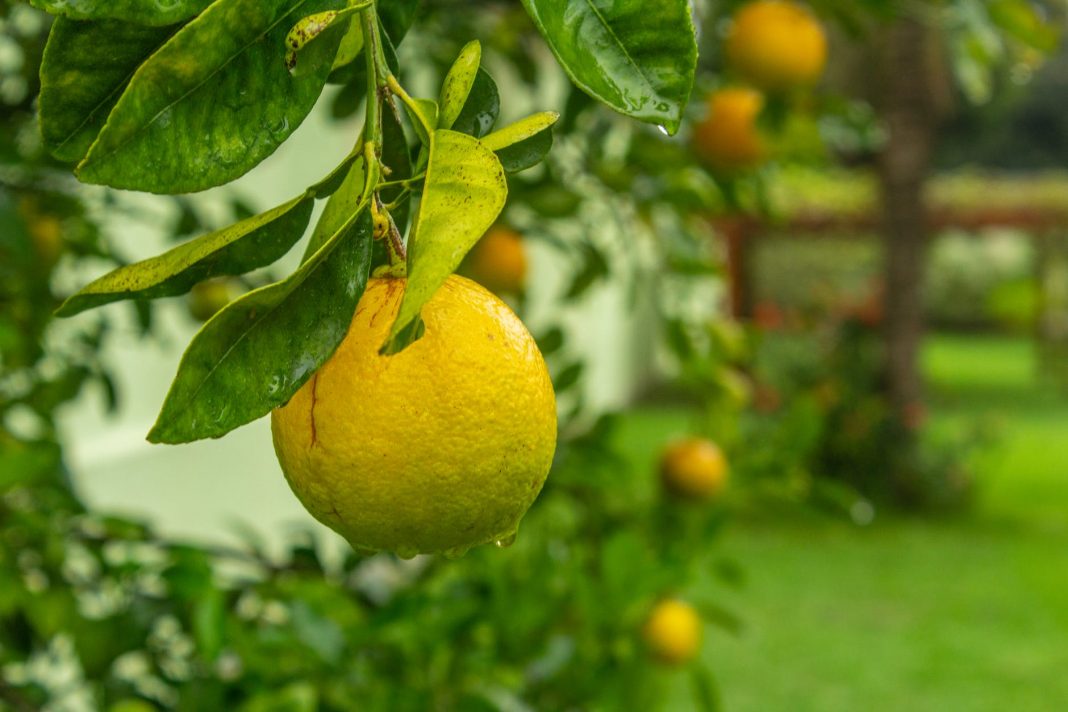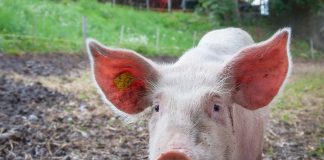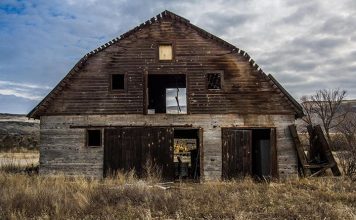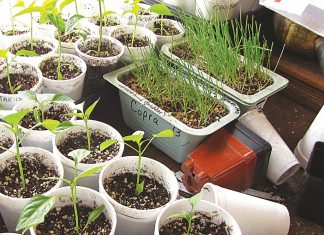 |
|
| Issue #121 • January/February, 2010 |
Although I’ve been homesteading for more than forty years, there’s always something new to learn. (I figure that if I don’t learn at least one thing every day, I’ve somehow failed.) One day while shopping for a few groceries a bearded gentleman stopped me. “Are you Jackie Clay?” he asked. Of course he was a Backwoods Home reader! It’s always fun to visit with readers, but I’m still kind of embarrassed to have people I don’t know recognize me. But I’ve made lots of friends that way, and this gentleman, Beryl Novak, soon became another.
It seems that Beryl is a self-taught fruit tree expert. He learned to graft trees years ago, and has turned it into a wonderful, huge hobby. Not only does he graft dozens of his own trees, but he travels to neighbors and friends, grafting their trees too. He’s like a modern-day Johnny Appleseed.

I’ve always been interested in grafting, but it seemed hard and fussy, so I never got around to learning. Beryl changed that notion in a few minutes, and invited me to his place to see what he was doing. When I stopped by, I got the tour of Beryl’s orchard in the woods.
Wow! There were dozens of trees that had several grafts each. Large trees, small trees, and everything in between. And Beryl knew each and every tree and graft like they were children. His friend works at Cornell University and sends him scion wood every year from all around the world, so not only does he have well-known American varieties grafted onto his homegrown trees, but also ones from Siberia, Norway, and other far-away countries. There are apples, pears, plums, and cherries. (I didn’t even know that there were pears that were hardy in northern Minnesotanow I have two growing in my orchard.)
I really enjoyed my visit and reserved two of his baby grafted apple trees to be delivered in the spring. I also accepted his offer to teach me how to graft. That was an offer I could not possibly refuse.
What is grafting?
It is not known how far back in history grafting began. By the 5th century BC it was widely practiced by the Greeks and Romans, and some authorities say it was practiced in China some 1500 years earlier. But when Europeans arrived in the Americas, grafting was unknown among the Indians, despite the fact that in many ways the Aztecs and Mayans of Mesoamerica and the Incas of South America were more advanced in the cultivation of plants than their Old World counterparts.
Today, however, grafting is used on a large scale in the orchards of the world and can be practiced by the self-reliant gardener. Nearly all domestic fruit trees today are grafted trees. Desirable fruit varieties are grafted onto the rootstock of extra hardy or dwarfing rootstock varieties, as the case may be. For instance, Beryl plants seeds and pits from crabapple and wild plums, then after the seedling trees gain size, he grafts desirable twigs onto them, turning them into domestic fruit trees.
|
You can graft a handful of scion wood from your neighbor’s best plum trees onto your wild plum seedlings and end up with several plum trees that would cost $30 each at a nursery. Or you can take prunings off your pie cherry tree and graft them onto wild cherry or chokecherry trees in the pasture and end up with a whole pie cherry orchard. Still another fun thing you can do with grafting is to make up your own “four on one” fruit trees, just like in the catalogs. You can have four (or ten) different varieties of apple on one tree. Or try cherries, plums, and peaches all on one “fruit cocktail” tree. You can even take that old apple tree in the backyard that doesn’t really have good apples and graft on several new buds, turning it into a great apple tree. The possibilities are endless.
True to his word, Beryl called me in the spring and a few days later he and a friend drove in. My friends, Jim and Jeri Bonnette, also wanted to learn how to graft fruit trees, so they came over too. We had our own “mini-seminar,” right out in my weedy, rocky, orchard-to-be. Beryl says that his best success in grafting is in the early spring, before the trees begin to bud out.
Here are some important terms related to grafting:
Scion: a piece of last year’s new growth with three or four buds on it
Understock: the part of the tree below the graft
Rootstock: the part that becomes the root of a tree
Cambium: the part of the tree beneath the bark that carries nutrients and water through the tree
Topworking: grafting onto the top of an established tree
Dormant: live trees at rest during the winter
Grafting tools
Beryl brought a medium-sized canvas bag out of the truck which contained the scion wood he’d brought to graft onto our trees and the tools of his trade. First, he showed us his grafting knife, a small, stiff-bladed knife. Then there are rubber graft-wrapping bands, which are long pieces of ¼-inch wide rubber (like a rubber band cut in half). They wrap around the graft union and hold the graft firmly in place until it begins to grow together, forming a new tree branch. Without the bands, the graft could slip, misaligning the cambium layers and causing the graft to fail. Grafting compound, also called tree wound compound, is brushed over the rubber grafting band and the cut-off top of the scion to keep the wounds from drying out. Drying will cause the graft to die. Other tools included zip-top plastic bags to hold different bundles of scion wood, a small pruning saw, and pruning shears.
The modified cleft graft
Beryl demonstrated the graft he uses most often, the modified cleft graft. This graft is easy to do and very versatile. It requires only a sharp knife, a steady hand, some rubber grafting bands, and a few dabs of grafting compound. You use twigs of about the same diameter, so they match quite easily. There is no difficult cutting necessary.
|
Beryl took a likely piece of scion wood out of his plastic bag that was from prunings from his neighbor’s old, productive, and very hardy apple tree. He snipped off the top of the twig, which was about eight inches long, just above an outward facing bud. He explained that you always cut above a bud that was pointed in the direction you wanted the branch to go. If you cut above a bud facing in, toward the central leader, or the main tall trunk, the branch would go inward and later cross the trunk, requiring pruning off. You want your branches to grow upward and outward, away from the trunk.
When grafting using this method, you need to leave at least two buds above the lower cut. This cut is made at a sharp diagonal, using one smooth motion. Don’t touch up the cut with another, or the cut may not be smooth enough to make a successful graft. Keep your knife sharp and cut deftly, but carefully, so you don’t cut yourself, too. Out of one piece of scion wood, you can usually make two grafts as long as the scion wood has enough buds.
On the tree, choose a healthy, young branch that was last year’s new growth. With sharp pruning shears, cut the top several inches off, straight across, just above an outward facing bud. Carefully split the branch in half, just deep enough to receive the scion wood. Now carefully insert the scion and line up the two pieces of wood so that the cambium layer meets in as many places as possible. If it doesn’t match up, the sap and nutrients cannot pass up into the newly grafted twig and it will dry up and die.
Now it’s time to wrap the graft. If you don’t have a rubber grafting band, you can certainly use a wide rubber band, snipped so it will make a straight piece. You can even use a piece of good quality electrician’s tape. You want flexibility and holding power. Hold one end of the band on the lower end of the graft and gently, but firmly, wrap the entire grafted surface in overlapping layers. Tuck the end of the band back into a wrap to finish it off securely.
Now dab grafting compound over the cut end of the scion wood and paint the entire graft and band with the compound. This helps the graft heal and prevents it from drying out. It also helps keep insects out of the grafted area until it heals over.
Your graft is complete and you are ready to move on to the next one.
At first, your success rate will be low; probably less than 50%. Like any other skill, it takes practice making your cuts, lining up the cambium layers, and wrapping the graft.
Don’t make just one graft on a treemake several. That way, when a couple fail to grow, you can still be thrilled with the others that succeeded. If you have several trees, you can easily graft several branches of each one of them. It doesn’t take many years at all to have a very productive and interesting orchard.
Getting your scion wood
One of the easiest and cheapest ways to get scion wood for grafting is to ask neighbors for cuttings off their wonderful trees. You know, the ones you’ve been drooling over for years. You will want to cut your scion wood when the trees are dormant in the fall or very early spring, before the sap has started to run. Cut pieces about a foot long from new growth; mark the top with a straight cut and the bottom with an angled cut. This way, it’s easier to tell top from bottom when the buds are too small to clue you in. (As they grow, buds point toward the end of the branch.) You don’t want to graft a branch on backwardit’ll grow that way.
|
Scion wood is easy to store. Simply wrap it in just damp (not wet) paper toweling, then put in a plastic bag and place the bundle in the back of your refrigerator crisping drawer. It’ll stay fine all winter and be ready to graft onto your trees in early spring.
If you have no neighbors or grafting hobbyists around, or you want to graft specific cultivars (varieties) onto your trees, you can buy scion wood from many commercial sources. There are not many good, Zone 3 fruits for me up here in northern Minnesota, so my grafting could be very limited if I didn’t know Beryl. But I can buy from out-of-state nurseries that sell a wide variety of scion wood from trees that are not only hardy here, but taste great, too. I can also find rare cultivars of old timey fruits that my great grandparents grew or that Thomas Jefferson plantedtrees with history.
Ask your County Extension Agent, too. Often he has sources of scion wood available from university experimental farms in your area. These sources are very useful, because chances are these trees will do well in your area.
Importance of rootstock
Rootstock is the bottom part of a grafted or to-be-grafted tree, usually a small tree the size of your finger or smaller. While we topworked some of our older existing trees, many times you will graft onto a young rootstock, creating a totally new tree. It is important to choose rootstock that has the characteristics you desire in the adult tree. If you want a super-hardy tree able to survive sub-zero northern winters, you must choose super-hardy rootstock that can withstand such low temperatures. When you graft a hardy variety onto a less hardy rootstock, you will end up losing the tree after a couple of winters.
|
This often happens where I live because many commercial nurseries are located in warmer climates. Research the type of rootstock used at the nursery you buy from. Even if the tree variety you buy is hardy in your area, if it is grafted onto a less-hardy rootstock, it will dieeven if you take good care of it.
The rootstock also determines the ultimate size of the tree. You can graft onto standard, dwarf, or semi-dwarf rootstock and have the resultant tree remain that size, regardless of the scion wood you have used. Choose your rootstock well and reap the benefits. Like scion wood, you can buy rootstock from a wide variety of sources. Most of the ones listed for scion wood also sell rootstock or can direct you to a source. If you really want to be creative (or if you’re cheap), you can grow your own rootstock, just like Beryl does.
Grow your own rootstock
What types of fruit trees will you be grafting? Will it be apples, plums, or cherries? There is a “wild” variety of each that makes excellent rootstock. Wild plums and cherries and old, hardy crabapples make great rootstock to graft domestic cultivars onto. Collect ripe fruits of the types you plan on using for rootstock. Work up a garden area well and fence it against deer, voles, mice, and rabbits. Plant your seed stock just like you would garden seeds. Water them well and let them overwinter. In the spring, they will put up nice healthy shoots, which will quickly grow into whips. When they are large enoughusually after a yearyou will be able to use them for rootstock for your grafting projects.
This does require a little forethought, but it is fun, saves a bundle of cash, and is very satisfying. My own Beryl Novak designer trees have rootstock from an ancient, extremely hardy wild crabapple. It’s not much to look at, except in the spring when it blooms, but it is extremely prolific and hardy. This tree puts out its own seedling suckers every spring, which Beryl turns into wonderful domestic apple trees.
Wild rootstock
|
You can also use wild rootstock for your grafting. This is about as wild as you can get without going truly wild. I can dig up some wild plum seedlings down on the edge of the pasture, bring them home and let them establish, then graft them. Or I can really get wild and bring my scion wood down to the pasture and graft away, right there. Soon I could have dozens of branches bearing domestic plums, right on my wild plum trees.
We have hundreds of pin cherries, chokecherries, and wild cherries on our land. If I graft some domestic cherry wood onto them I could have an instant cherry orchard on super hardy rootstock.
The key to success in such wild grafting is to use scion wood and rootstock of the same type of tree. For instance, graft apple (malus) to apple or crabapplethey’re all apples. Likewise, you can use “wild” pears as rootstock (seedling hardy pears) and graft domestic cultivars onto it. Or you can graft stone fruit to stone fruitplums, cherries, and peaches are interchangeable. But you can’t graft a cherry onto an apple, a pear onto an apple, or a cherry onto an apple or pear.
If you’d like more detailed information on grafting fruit trees, including other types of grafting such as bud grafting, bridge grafting, or tongue grafting, check the internet. Type in “fruit tree grafting” and you’ll find great sites, including several from university fruit specialists that will provide you with much information and helpful drawings.
Ask around to see who else is into grafting in your area and visit with them. Most of these folks love sharing their scion wood and hints, and you might even find someone to give you your very own “mini-seminar” like Beryl did for Jim, Jeri, and me. Like everything else, hands-on experience is always the easiest and best way to learn a new skill.
Grafting fruit trees is a new venture for me, and hopefully a lot of you will come along with me and learn this creative and useful skill. The price of fruit trees has nearly doubled at many nurseries this year. This, in itself, should provide the gentle shove toward more self-reliance on the homestead. Growing your own fruit trees from scratch is addicting and oh so satisfying! Thank you, Beryl.



















An impressive article, indeed! I can’t wait to print it and add it to all my own notes and knowledge. I’m looking forward to learning bud, bridge, and tongue grafting. Thanks, Jackie
Please can you help finding out how many different types of trees you can use to graft with writing my own book in England uk,first the pear rowen tree,whitebeam ,willow leaved pear Siberian crab apple crataegus cocksure thorn tree,midland hawthorn oak quereos fagaleae ,now doing the apple tree,,also the raspberry gooseberry ,Ribes ,and going through the flowers ,dahlia,penigolium ,there is so many if you could help me ,just reading your grafting which I thought maybe you could help,please keep in touch I am over 82 years old now passed biology inn1954,long time ago,now studying electricity in plants ,so much more to learn ,in case you miss it my email address is robertpeterd7@gmail,com bob Dunford from Kent in England thank you for taking the time reading this all the very best waiting for your reply